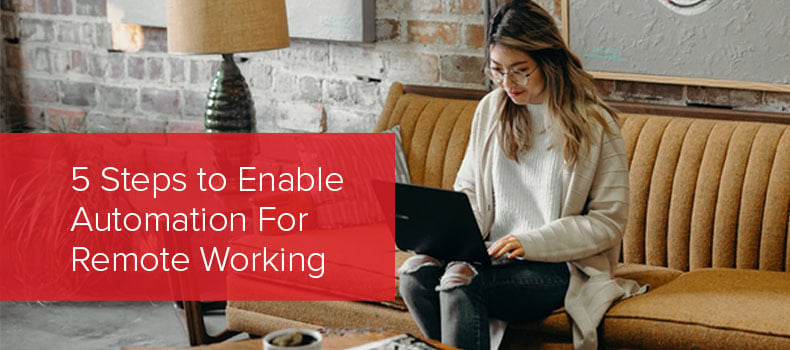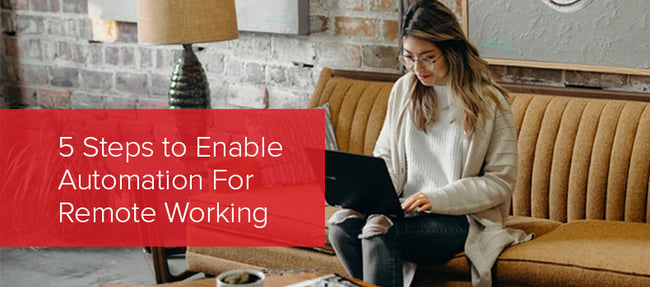The Covid-19 pandemic might be responsible for forcing businesses to close their office doors and send people to work remotely, but in the larger case of remote working, it’s merely a catalyst for a growing trend. For many, this time of remote working has shown them that they are capable of doing their job from home and with the right technology, can actually be more productive and efficient.
That said, there are many office processes that haven’t easily translated to remote working - any paper-based or signature dependent processes have suffered from the lack of ability of walking over to someone else's desk and asking them to sign something or dropping off a printed document on their desk.
We’ve even heard stories of courier companies being used to go between the houses of company senior executives so they can sign a document with a wet-ink signature.

But it doesn’t have to be like this. Just because a company has always done a process in a certain way, doesn’t mean that process can’t change. As many employees choose to continue working from home for the foreseeable future and likely far beyond as they settle into their new working environment, businesses need to adapt and provide processes that work for everyone in the organisation, whether they are remote or office based.
Thankfully, many business processes do have a digital alternative and further still, automation options are available to make these processes even more efficient. Here are 5 steps to enable automation for remote working:
1) Take a people first approach
For any business change to succeed, you have to consider the people involved and the end-users. This is actually a multi-faceted step as you have to think about how people are currently working remotely and the difficulties they might be facing, but also how change can be introduced without too much disruption.
In order to minimise disruption, start by introducing digital tools and automation that help employees with everyday tasks, such as signing or annotating a document.
2) Review the processes that could be automated
Even if your organisation has been following the same processes for decades, that doesn’t mean it can’t be automated and made more efficient. Sometimes, a process only works because of the environment it’s being used in - once that environment is changed, such as with remote working, the processes aren’t so efficient anymore.
This often applies to any intensive paper-based process but also, it applies to slow, repetitive tasks that take a lot of employee time. By reviewing these processes, you can begin to identify those that are ideal for automation - one such example being the accounts payable process which often involves a lot of office-based repetitive tasks and can be quickly automated so that the process can be done remotely as well!=
3) Consider operational blocks
“Many businesses find it challenging to maintain operational efficiencies with fewer people and uncertain future demand… Companies can do one of two things: they can become paralysed by the uncertainty and hope things go back to the ‘old normal’, or they can make informed, bold decisions based on data, intuition and experience to ‘win in the turn’.” Chris Huff, chief strategy officer at Kofax - 6 ways a remote workforce can harness automation, Silicon Republic.
The future of workplace processes is going to rely heavily on automation - not only to optimise processes but to make them more cost effective, and importantly, give time back to employees to work on higher-value tasks.
One of the trickiest steps in enabling automation is identifying and considering the operational roadblocks that stop things moving forward. This can include anything from IT pushback through to stakeholders not wanting to change. Consider this early on and you’re more likely to overcome these blocks and proceed with automation.
4) Prepare for change
Another blocker for new technologies and automation is change management.
It’s important to note that that automation isn’t about replacing human employees, it’s about leveraging technology to compliment the work humans do and take away the slow, repetitive tasks that can be better done by software.
Preparing for change in this scenario is as much about preparing for more people working remotely as it is bringing in updated processes that make the most of automation.
5) Think about the future
“The new normal will see a future of work where mobile, automation, cloud and AI technologies provide the means to develop business moats. Those that learn to leverage the full capabilities of these technologies to deliver the ultimate customer experience will prevail in the new normal.” Chris Huff, chief strategy officer at Kofax - 6 ways a remote workforce can harness automation, Silicon Republic.
The future is always difficult to predict, but with everything that happened in the first half of 2020, you have to consider if it could happen again - possibly due to a different scenario, but if your whole workforce is made to work remotely, how can you ensure that everything continues as normal?
Automation can help to prepare the organisation for future disruptions and future trends including more people choosing to work from home. As many organisations have found recently, trying to automate processes after everyone has already been forced to work from home is more difficult than already having it in place allowing for a seamless transition.
There is no silver bullet to automation, but if you’re seeing the same thing as many organisations, more and more employees will choose to work remotely in the future and you need to have a way to keep employees productive and working as usual.
Automation is a great way to do this as it doesn’t rely on paper-intensive processes and people being in the same physical space!

